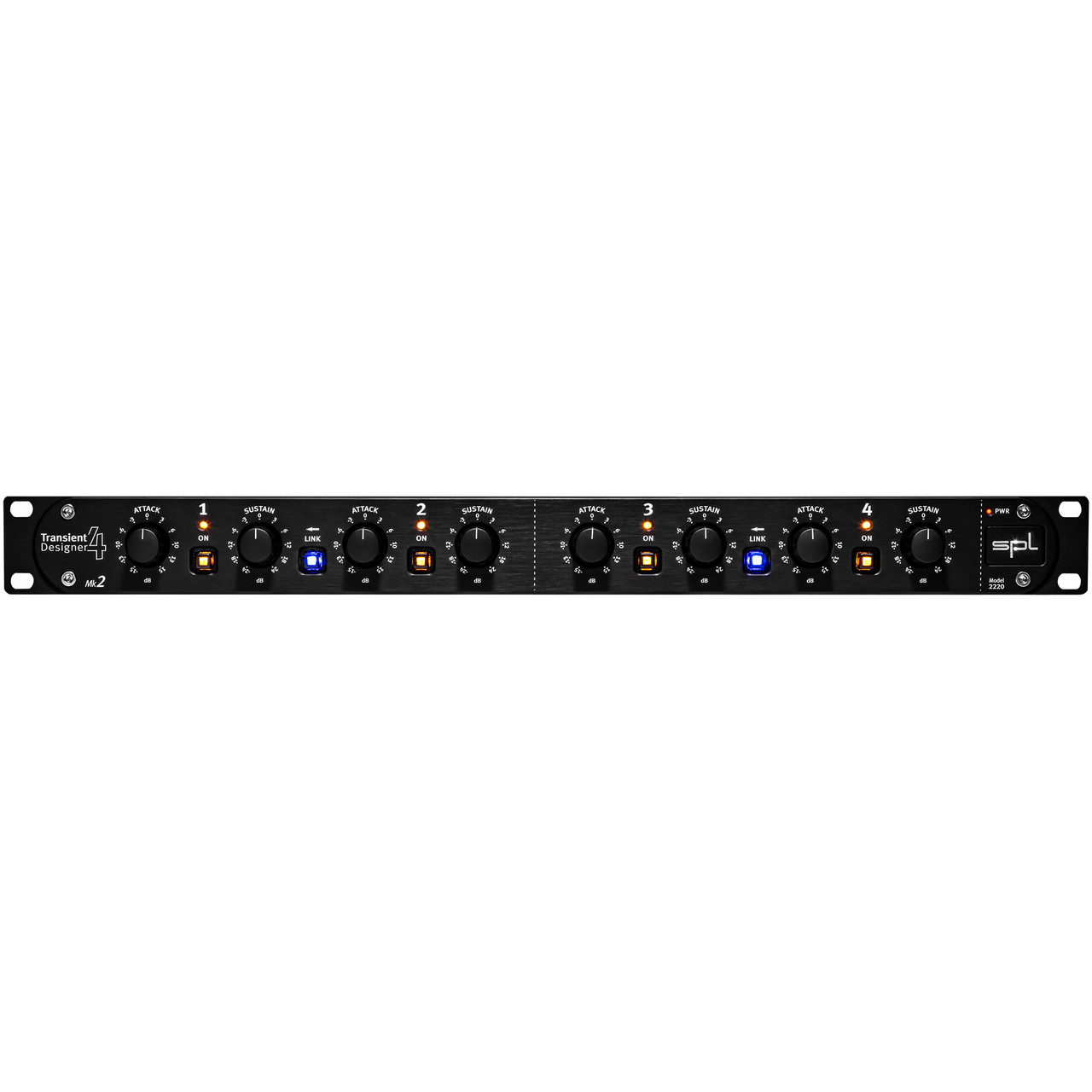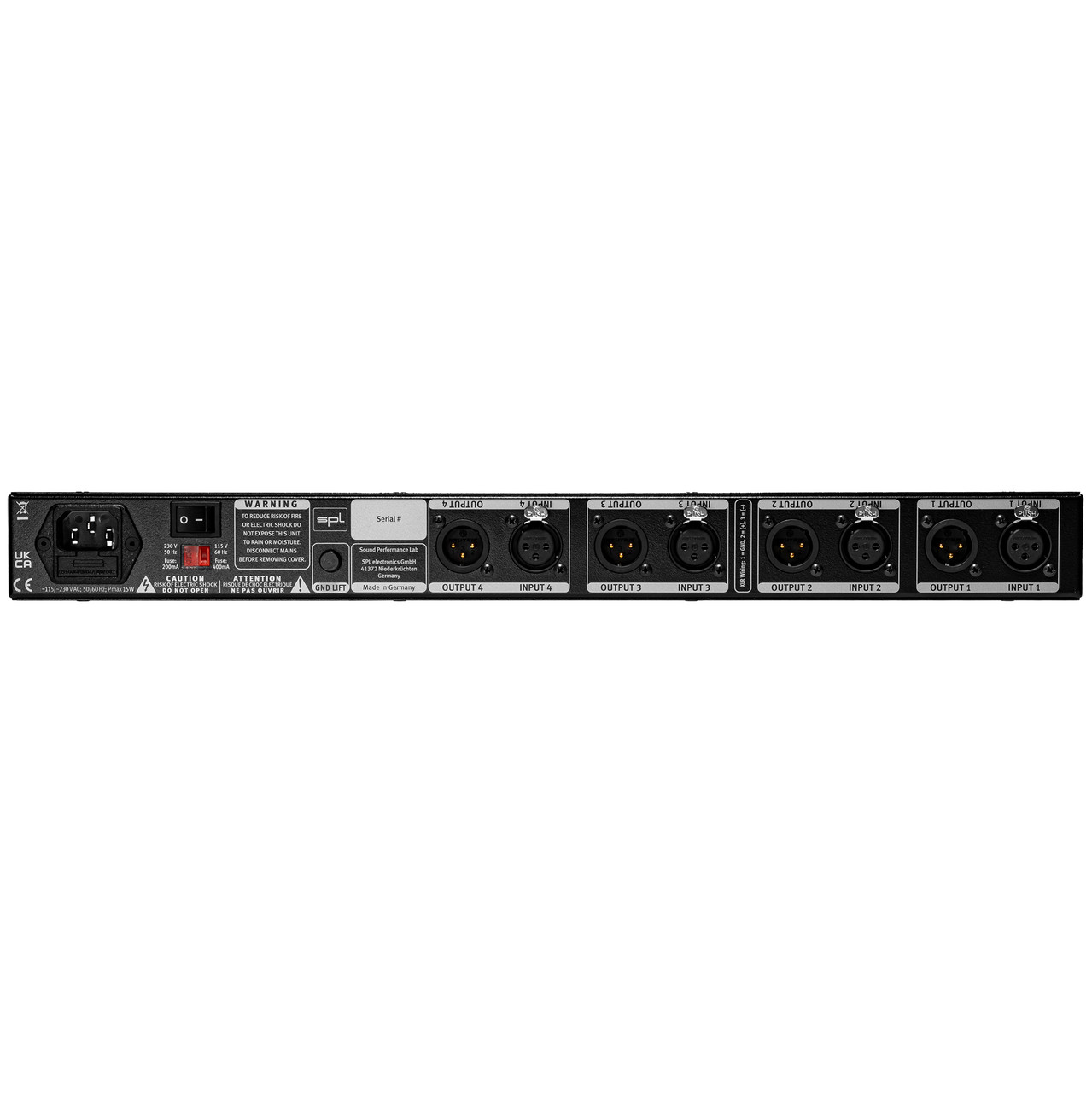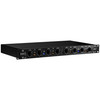The SPL Transient Designer 4 MK2 Dynamics Processor is a legendary piece of gear in it's own right. Long has it stood as the standard for transient shaping, making it an invaluable tool for engineers around the world.
The SPL Transient Designer 4 MK2 Dynamics Processor provides a revolutionary concept for dynamic processing rendering controls such as Threshold, Ratio and Gain superfluous. The Transient Designer's automation is highly developed, so that while the processing going on inside the box may be very complex, the user has to deal with just a few intuitive controls.
Differential Envelope Technology
SPL's Differential Envelope Technology is the first analog solution for level-independent shaping of envelopes allowing transients to be accelerated or slowed down and sustain prolonged or shortened. The degree of dynamic processing required to do this couldn't be duplicated even using a chain of several conventional compressors, yet only two controls per channel are required to allow the user to completely reshape the attack and sustain characteristics of a sound. Attack can be amplified or attenuated by up to 15dB while Sustain can be amplified or attenuated by up to 24dB, enabling weak drum sounds to be made much more percussive and powerful, or for over-percussive transients to be softened. All necessary time constants (Attack, Decay and Release) are automated and optimised adaptively in a musical manner according to the characteristics of the input signal. This results in natural sounding signal processing and fast operation.
How Does It Work?
The SPL Transient Designer 4 MK2 Dynamics Processor uses envelope followers to track the curve of the natural signal so that optimum results are guaranteed regardless of the input signal's dynamics. Because of the level-independent processing inherent in Differential Envelope Technology (DET), manual threshold adjustments are not required. In order to maintain the cleanest possible signal path, the Transient Designer uses the excellently specified THAT 2181-VCAs, which are especially natural sounding, transparent and create minimal distortion. High amplitudes are processed without damping of high frequencies or reducing bass.
Sound Benefits
- The attack of a bass drum or a loop can be emphasised with a single control to increase the punch and the penetration in the mix Sustain of a snare or room-sound can be shortened very musically to clean up the mix for more transparency Acoustic or electronic instruments become "in the face" sounds or can be smoothened with lower attacks
- De-verb capability! Less Sustain shortens reverb flags of any sound (more elegant than gates do)
- New panorama effects based on different dynamic effects per channel - try this with loops for example.
Other features and connectivity
For stereo operation the Link function connects channel pairs (1 and 2 and/or 3 and 4). Linked channels are controlled by the same side-chain voltage so as to maintain a coherent and stable stereo image. When operating in Link-mode, the control elements of the first (or third) channel, including the Active switch, control the second (or fourth) channel, too.
Each channel is equipped with a relay hard bypass circuit to ensure a minimum signal path when the process is bypassed and to provide power fail safety. The Signal-LEDs allow to quickly monitor the signal flow, which is particularly important if the four channels are connected to a patchbay. The Transient Designer is fitted with XLR-connectors for balanced operation. To improve signal quality, SPL has developed a new hybrid-component balanced input/output stage using all laser-trimmed resistors with a tolerance of 0.01%. This approach has resulted in an exceptionally high CCMR (common mode rejection) better than -80dB at 1kHz.
SPL Transient Designer 4 MK2 Dynamics Processor Features
- Drums & Percussions
- One of the most interesting applications of the Transient Designer is processing drum and percussion sounds, both from samples to live drum sets:
- The attack of a bass drum or a loop can be emphasised to increase the power and presence in the mix.
- The sustain period of a snare or a reverb-flag can be shortened in a very musical way to obtain more transparency in the mix.
- Recording a live drum set, toms or overheads can be shortened without physically damping them.
- Miking live drums is considerably faster and easier, because the apparent 'distance' of the microphone can be corrected by varying the ATTACK and SUSTAIN values.
- The Transient Designer is a perfect partner to noise gates in live drum miking.
- Corresponding adaptively to the duration of the original signal, the sustain can be shortened more musically than with tightly adjusted release times, effectively reducing crosstalk.
- When recording live drums or other instruments on a HD recording system, the Transient Designer prevents time-consuming removing of crosstalk signals on the hard disk.
- It is possible to create unusual dynamic effects, including new and interesting pan effects. If, for example, a mono loop is patched through two channels of the Transient Designer panned hard left and right in the mix, such that the left channel is processed with increased attack and reduced sustain while the right channel is adjusted in the opposite way, a very special stereo loop sound is created. You have to try this to appreciate what it sounds like, but expect to hear a lot of unusual stereo movement.
- By reducing attack and increasing sustain, signals that are too up-front sounding can be moved back into the mix. Additionally the FX parts of 'too dry' signals are strengthened.
- Drum sounds are easier to integrate into the mix. If the acoustic level of a snare is expanded to approximately +4dB by increasing the attack value, the effective increase of peak levels in the overall mix is merely about 0.5dB to 1dB.
- One of the most interesting applications of the Transient Designer is processing drum and percussion sounds, both from samples to live drum sets:
- Guitars
- Used for processing guitar sounds, the Transient Designer softens the instrument by lowering the attack. Alternatively, increasing the attack lets the sound jump to the front of the mix, which works particularly well for picking guitars.
- Highly distorted electric guitars are already highly compressed, leaving them with minimal dynamic range. This can obscure the note attacks, but increasing the attack setting clarifies the individual notes. High distortion also prolongs the sustain, broadening the sound. Reducing the sustain setting counteracts those effects.
- Increasing the sustain period of miked acoustic guitars produces clearer audible stereophonic sounds. Reducing the sustain value can help dry up the sound.
- Choirs & Backings
- When recording choirs, the effect of too much 'ambience' can be reduced by using a lower sustain setting.
- Reversely, not enough room can be added by turning up the Sustain control.
- Keyboards, Samples & Drum-Machines
- Frequently keyboard and sample sounds are intensively compressed leaving little of their original dynamic range. Increasing the attack brings back the natural dynamics so the sounds need less space in the mix and are easier to pick out, even at lower levels. With the help of the Transient Designer 'budget' drum machines can provide sounds and grooves that sound far more powerful and dynamic than the original untreated sounds.
- Movie Post Pro
- Effect sounds and sample libraries benefit from more punch and more power useful when working on TV commercials or movie soundtracks. 'Out door' recordings often suffer from poor microphone positioning. The Transient Designer can help create the effect of re-positioning the mics during the mix.
- Mastering
- However, like any good thing, you have to know where not to use it. For example, use in mastering is not recommended as it's rarely a good idea to treat a whole mix at once. Instead, treat individual elements within the mix.
- Nevertheless, we have been noted by our customers that a little less sustain and a little more attack can effecively tighten a mix.
SPL Transient Designer 4 MK2 Dynamics Processor Specifications
- Maximum input gain: 21 dBu
- Input impedance: 22 kΩ
- Maximum output gain: 21 dBu
- Output impedance: 100 Ω
- Common mode rejection (1 kHz): 80 dB
- Frequency range (-3 dB): 10 Hz – 100 kHz
- THD + N (0 dBu, 10 Hz – 22 kHz): -90 dB
- Noise (A-weighted): -97 dBu
- Dynamic range: 118 dB
SPL Transient Designer 4 MK2 Dynamics Processor Includes
- Transient Designer 4 MK2 Dynamics Processor
- IEC Power Cable
- Manual and Warranty Information
1 Review Hide Reviews Show Reviews
-
amazing!
May 26th 2011this thing should be in everyone's rack...there is just nothing like it and while i have been able to use the plugin to save my butt in a tight spot, the hardware just seems to to it so much more elegantly. i work with a lot of jazz guys where dynamics are still really important to the artist. the ability to tastefully and musically shape the attack and sustain of even the quietest phrases make this tool an absolute godsend. i don't know what i did without it. i'm gushing a little but until you hear it take a washy, terrible room and evaporate it from a drum take making the drums come alive and punch you in the face, you won't know what i'm talking about...just try it. it is only two knobs...mindblowing!
Write a Review

















 Sign Up for exclusive sales and offers!
Sign Up for exclusive sales and offers!